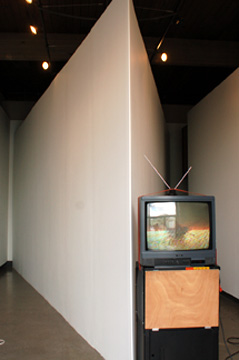
Installation View: BYOTV, NAAU 2008
Dear (Video) Ladies and Gentlemen,
The death of an era is upon us. On February 17, 2009 the FCC will terminate the broadcast transmissions of analog signals in favor of an entirely digital broadcast system. To receive these new signals, one must own either a digitally receptive television or purchase an analog converter, for which the government has issued coupons and for which may be applied through various FCC websites. Such a change will mark something quite significant, as the government's clammy dip into something so personal as our television scented daily lives feels perhaps a little too close for comfort. For the first time ever we will be governmentally mandated to update our televisions. What this will mean for the American public is up for discussion, not only logistically but culturally. Despite the fact that the topic happens to be mere electronic pathways, invisible conduits for the transmission of our Jerry Springer and Seinfeld, our cartoons or the nightly news, this technological wonder revolutionized the world in such a way that the strength and plethora of its subcultures proliferated. Televised analog signals became somewhat medium unto themselves, the very material of moving images becoming metaphysical, existential, a stuff to wield and analyze.
The first group of juried shows the NAAU has lined up for the coming year spotlights the true lovers (and soon to be mourners) of the analog signal in the tribute, BYOTV, the Video Gentleman's elegiac concert to this era. Alas, analog lovers unite, for this is a celebration. The artists encourage visitors to the gallery to bring their own t.v.'s, as the title of the show suggests, so that they may pick up their own signals with various, idiosyncratic results. For the entire duration of this exhibition, the Video Gentlemen have scheduled a variety of programming that explore the contribution of the transmission of images and sound via cathode ray tube, magnet, and electricity and the various quirks and magic upon which its recipients corroborated.
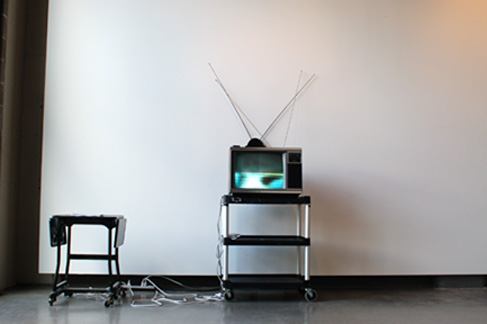
Installation View BYOTV, NAAU 2008
Carl Diehl's "Blobsquatch: Patrolling the Ether" documents the work and interests of those fascinated by EVP or Electronic Voice Phenomena. These groups dedicate much of their lives to the detection of voices or images within what has become a rather electric atmosphere.
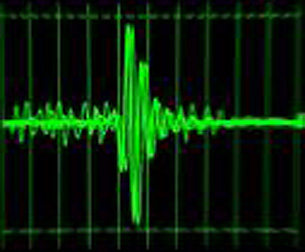
EVP Soundwave
With so many different types of signal being transmitted through our atmosphere, EVP subscribers believe there to be much undetected communication occurring in the in between of received signals. This communication is believed to be conducted by supernatural beings or ghosts. There are many who in fact believe that the deceased have the power to communicate through these superfluous waves and wish to intercept messages from beyond the grave. The "Spy Numbers Stations" suddenly detected during the Cold War were a similar sort of secret communication discovered and investigated yet were later believed to be communication between spies rather than spirits. In light of this coming February, Diehl's documentary suggests perhaps an end to these analog mystics' ease of access to their own religion and folklore, to what Diehl's documentary deems "sanctuaries for eclectic electronic ecosystems" or "active electronic ghostlands."
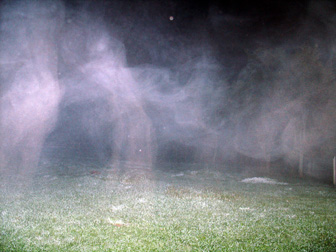
Ghosts Image Courtesy National Ghost Hunters Society
Truly, this show lauds the trappings of mad scientists, supernaturalists, and audio visual theorists, those that appreciate the intellectual property surrounding certain phenomena and aesthetics within great melting iceberg bits of culture. The exhibition is visually sophisticated, tightly highlighting the rather pointed notion of a relatively new beauty: the sleek, minimal, electrical beauty of Atari games, brand new appliances, and noise as music. This is the beauty of the flesh of the invisible, of transmitted electricity, the force that powers mouthwatering transmissions of our pop cultures, our entertainment, and many of our ideals. The Video Gentlemen have ingeniously translated this space into broadcast station, performance space, and hip electrical enclave. The catalogue for this show is art unto itself, each page graphically lovely and powerful enough to jog the memory of anyone who happened to own any sort of instructional manual for any piece of audio/visual analog receptor in the past thirty years.
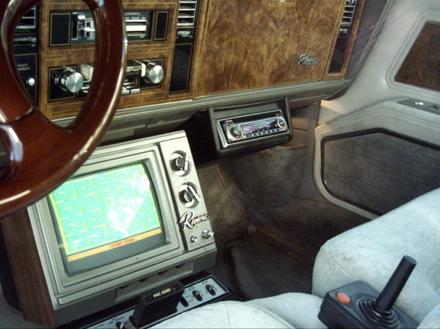
Atari Equipped '79 Buick Riviera Image courtesy Computer History Museum
Thus the eccentric hearts that sicken at the loss of analog broadcast lose more than their television sets; they lose their mechanics, the beauty of visual electrical error and function, the sort of humanity of electric signals. We have finally reached a technological age old enough to be nostalgic about our electricity. The switch from analog to an entirely digital broadcasting system is intended theoretically to make more money for all, to ease the burden of the federal deficit, to allow emergency response units easier communication with one another, and of course, to watch (even) more and better tv. Yet the public consequences of this enormous switch go relatively undiscussed on either local or global levels.
According to blogger Jahn, Some people do indeed like the hills and valleys in their English muffins or the blobby gaps in their analog broadcasts. Yet those who espouse the digital age cannot seem to understand this. The Video Gentlemen's programming this month is the reification of the worlds within worlds of those electronic hills and valleys about to be destroyed by mandated commerce. An analog anthology in real and recorded time, BYOTV is a preemptive tribute to the living medium of an era that parented most of our lives and imaginations. Will the digital age serve our analog brains as well? Only real time will tell.
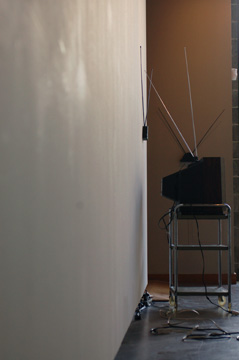
Installation View BYOTV, NAAU 2008
This line in particular is incredibly perceptive, "We have finally reached a technological age old enough to be nostalgic about our electricity."
It is so true... I'm a guitarist and there is a lot of truly mad fistishing of things like vacuum tubes and germanium transistors... but in this case the nostalgia is a lot more pervasive. Most everyone in the USA gre up with an analog TV.


























![[TypeKey Profile Page]](http://www.portlandart.net/nav-commenters.gif)